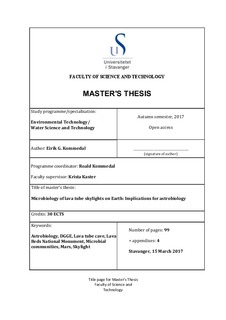| dc.contributor.author | Kommedal, Eirik Garpestad | |
| dc.date.accessioned | 2017-06-08T12:25:02Z | |
| dc.date.available | 2017-06-08T12:25:02Z | |
| dc.date.issued | 2017-03-15 | |
| dc.identifier.uri | http://hdl.handle.net/11250/2445460 | |
| dc.description | Master's thesis in Environmental Technology | nb_NO |
| dc.description.abstract | Microbial life is abundant in Earth’s subsurface and is extremely diverse. Subsurface habitats on extraterrestrial bodies offer microorganisms protection from hostile surface conditions. Lava tube caves are widespread on Earth; they provide access to subsurface microbial habitats and contain extensive microbial communities. In addition, they have been identified on Mars and on the Moon by their skylights. There is a lack of knowledge on how microbial communities in lava tube cave skylights differ from microbial communities in deep cave zones and overlying surface soils. This study is the first comparison of bacterial communities in lava tube cave skylights with communities in the cave deep zone and the overlying soil surface. To examine these differences, denaturing gradient gel electrophoresis (DGGE) was used to analyze and compare bacterial 16S rRNA diversity in samples from microbial mats, secondary mineral deposits, and soil samples from three lava tube caves in Lava Beds National Monument, CA, US. DGGE analysis revealed a higher bacterial diversity in the soil surface community than in the skylight and deep zone communities. The lowest diversity was found in secondary mineral deposits samples from the cave deep zone. Independent of their origin, soil samples were more diverse than secondary mineral deposits samples. Future research should focus on improving our knowledge of microbial diversity and function in lava tube caves, and how this knowledge can be used to select the locations with highest potential for detecting life on extraterrestrial bodies. | nb_NO |
| dc.description.sponsorship | Tekna - Teknisk-Naturvitenskapelig Forening, ONS, Universitetet i Stavanger, Mars Institute | nb_NO |
| dc.language.iso | eng | nb_NO |
| dc.publisher | University of Stavanger, Norway | nb_NO |
| dc.relation.ispartofseries | Masteroppgave/UIS-TN-IMN/2017; | |
| dc.rights | Navngivelse 4.0 Internasjonal | * |
| dc.rights | Navngivelse 4.0 Internasjonal | * |
| dc.rights.uri | http://creativecommons.org/licenses/by/4.0/deed.no | * |
| dc.subject | environmental technology | nb_NO |
| dc.subject | water science and technology | nb_NO |
| dc.subject | astrobiology | nb_NO |
| dc.subject | dgge | nb_NO |
| dc.subject | lava tube cave | nb_NO |
| dc.subject | lava beds national monument | nb_NO |
| dc.subject | microbial communities | nb_NO |
| dc.subject | mars | nb_NO |
| dc.subject | skylight | nb_NO |
| dc.subject | miljøteknologi | nb_NO |
| dc.title | Microbiology of Lava Tube Skylights on Earth: Implications for Astrobiology | nb_NO |
| dc.type | Master thesis | nb_NO |
| dc.subject.nsi | VDP::Teknologi: 500::Miljøteknologi: 610 | nb_NO |

